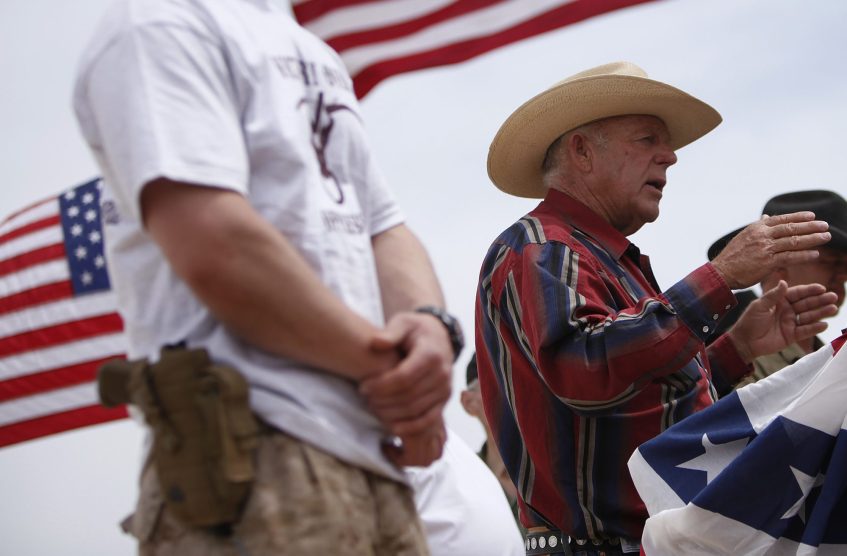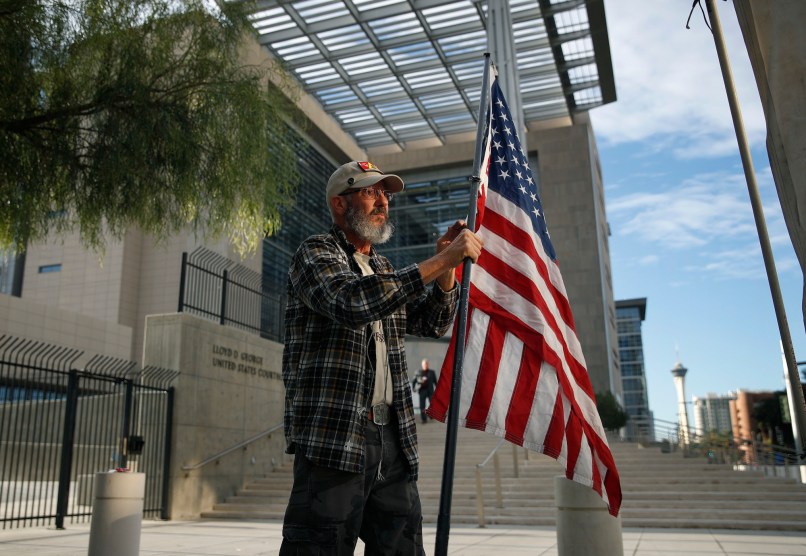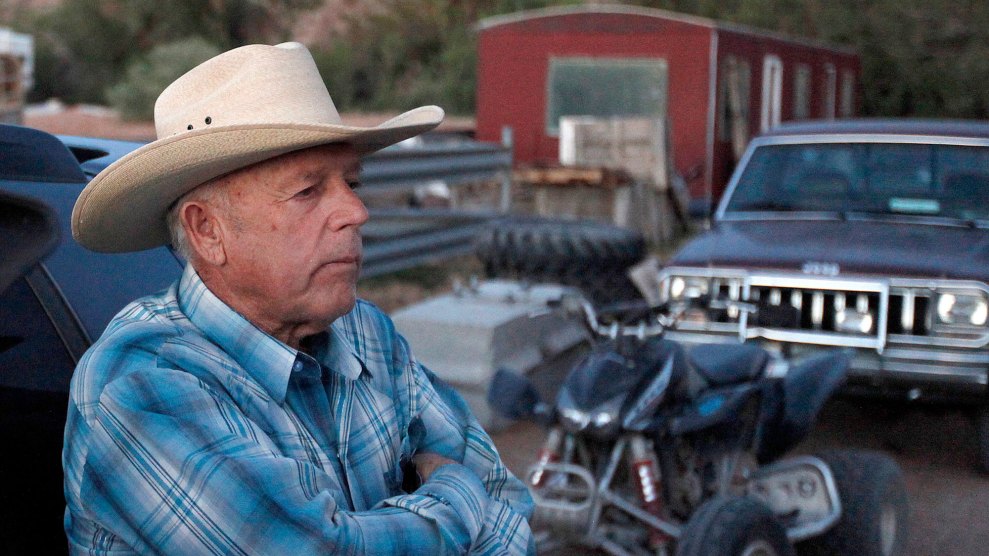
Rancher Cliven Bundy, flanked by armed supporters, speaks at a protest camp near Bunkerville, Nevada, in 2014.John Locher/Las Vegas Review-Journal via AP
Update 12/20/17: US District Court Judge Gloria Navarro declared a mistrial on Wednesday in the prosecution of Cliven Bundy, his sons Ammon and Ryan, and Montana militiaman Ryan Payne, saying that the government had willfully withheld evidence from defense lawyers that was potentially helpful to their case, in violation of legal rules. Navarro set a new trial date of February 26, but that could change at a hearing scheduled for January if she decides the government’s conduct is so egregious that the charges should be dismissed entirely.
On the November day when the trial of Nevada rancher Cliven Bundy was supposed to start in Las Vegas, I met a man outside the courtroom named Doug Knowles. A Bundy supporter who had been covering the proceedings for a conservative website, Knowles confidently assured me, “This case is never going to get to a jury.”
I thought he was overly optimistic. After all, on its face, the government’s case seems like a slam dunk. Much of what the Bundys and the other defendants did was captured on video. The photos of protesters pointing semi-automatic weapons in the direction of federal officers are damning. The government has thousands of emails and Facebook messages from the Bundys and others implicating them in the effort to recruit armed gunmen to face down federal officers. At least one of the original defendants in the case has taken a plea deal in which he agreed to help the prosecution.
Barely a month later, though, Knowles’ prediction seems prescient. The government’s case against Bundy, his sons Ammon and Ryan, and Montana militiaman Ryan Payne over their participation in the armed standoff near Bundy’s ranch in Bunkerville, Nevada, is in shambles. A federal judge, Gloria Navarro, could declare a mistrial as early as Wednesday based on allegations that the prosecution has failed to turn over critical evidence to the defense in a timely fashion. If that happens, it would mark the fourth time in the past year and a half that the Justice Department has put the Bundys and their supporters on trial and largely failed to convict them.
The Bundys first got the better of law enforcement in 2014, when the Bureau of Land Management attempted to impound hundreds of Cliven Bundy’s cattle around his Bunkerville ranch. Bundy had been grazing the cattle illegally on public lands for more than 20 years and owed the government more than $1 million in fines and overdue grazing fees. The BLM attempted to enforce a court order to seize the cattle. In response, Bundy and his family called in militia members from across the country to do “whatever it takes” to prevent the BLM from seizing the cows. The BLM ultimately gave up to avoid bloodshed, and the government failed to arrest any of the standoff participants for nearly two years.
Emboldened by the BLM’s defeat, Ammon Bundy led a group of armed supporters last year to Oregon, where they took over the Malheur National Wildlife Refuge for 41 days, ostensibly to support ranchers in Oregon who had been sentenced to jail time for setting a fire on public lands. The FBI shot and killed one of the occupiers while trying to arrest him, and Ryan Bundy also was shot and injured.
The evidence against the Bundys was overwhelming: There was extensive video footage of the Oregon takeover, and of the two dozen or so militants inside the refuge, no fewer than nine were FBI informants. And yet, in October 2016, an Oregon jury acquitted Ammon and Ryan Bundy and five other defendants on all of the charges stemming from the wildlife refuge takeover.
This February, six of the lesser figures in the Bundy ranch standoff went on trial. The jury convicted two of the men, but the judge declared a mistrial for the other four in April, after the jury reported being hopelessly deadlocked on most of the charges. The government retried those four men over the summer, and in August, a jury acquitted them of most of the charges and deadlocked on the remaining ones. The government planned to try two of the defendants for a third time this fall, along with Cliven, Ammon, and Ryan Bundy, but they pleaded guilty to minor charges before the trial started and will not serve significant jail time beyond their long pretrial detention.
When the trial of the three Bundys plus Ryan Payne finally moved to opening statements in November, the government immediately ran into problems, largely of its own making.
At the heart of the case against the Bundys is a conspiracy charge alleging that the Bundys and other defendants lied about their situation when they sent out urgent national requests for militia members and other armed protesters to come to Bunkerville to face off against the BLM. The indictment alleges that the family used “deceit and deception” to recruit followers and gunmen, falsely claiming that the BLM had surrounded the Bundy ranch with snipers and that federal officers had used excessive force against Cliven’s son Dave Bundy, who was arrested a few days before the armed standoff while taking photos and protesting along a state highway.
But those claims, dismissed by the government as fiction by paranoid anti-government activists, have largely turned out to be true. And it’s taken the government nearly two years, and three trials, to admit as much in court.
The first disclosure came during an evidentiary hearing in October, just days before jury selection was set to begin. Ryan Bundy, representing himself, questioned a National Park Service employee about the surveillance cameras he alleged were set up near the ranch. The government had denied that they existed, but the Park Service employee acknowledged the presence of at least one camera trained on the ranch that was operated by the FBI. She said she had viewed some of the footage from it. In the same hearing, the defense was able for the first time to question Dan Love, the special agent in charge of the BLM’s law enforcement operation at the Bundy ranch. He disclosed during his testimony that there were indeed snipers around the ranch and that the government had commissioned a number of threat assessment reports on the Bundys. Those reports had not been turned over to the defense lawyers, despite their requests for them.
Navarro is now considering whether the government failed to turn potentially exculpatory evidence over to the defense, including FBI reports and the threat assessments reports, which defense lawyers finally received last month. She sent the jury home for a week while she considered a defense motion to dismiss the case. The jurors return to the courtroom on Wednesday, when Navarro will reveal the outcome of her deliberations and could declare a mistrial.
Prosecutors clearly view all of these arguments about the snipers and surveillance cameras as pointless digressions that have nothing to do with whether or not the Bundys are guilty of the crimes they’re charged with. Exasperated prosecutors filed a motion on Monday asking Navarro to limit the Bundys’ arguments to what’s actually allowed by the law. They argue that the Bundys’ self-defense claim is nonsense and not allowed under recognized legal precedent. Prosecutors are asking the judge to bar the Bundys and Payne from arguing before the jury that the BLM provoked them into violence.
The mere presence of officers enforcing a legal court order, the government argues, is not justification for a violent confrontation, even if they include snipers. “Whatever the term ‘sniper’ means to the defendants—it reduces to this: cops have guns and have specialized training, each of which is allowed,” the government’s motion says. “The government has no evidence, none, that snipers, or any other federal officer, used any force—let alone excessive force—against the defendants or anyone else. Neither do the defendants.”
The skirmish over the withheld documents is only the latest in a string of problems for the government. Last year, Payne alleged that his calls with his lawyer, which are protected under confidentiality rules, were being recorded by the jail where he was detained. His lawyers asked the judge to ensure that the recordings were not turned over to the prosecution. The judge denied the motion, accepting the prosecutors’ insistence that they had no such recordings. As it turned out, the government did have recordings of calls between at least one other defendant in the case, Blaine Cooper, and his lawyers, obtained through the same system that recorded Payne’s calls with friends and family. Payne’s lawyers asked the judge to dismiss the charges against him on the grounds that the government likely had recordings of Payne’s conversations with his lawyers as well, a violation of attorney-client privilege rules and Sixth Amendment protections. The judge hasn’t yet ruled on that issue.
Also dogging the government’s case is the problem of Dan Love. Love should be the government’s star witness. Instead, the BLM recently fired him for misconduct in another case and for improperly using his position to get coveted tickets for friends to attend the Burning Man arts festival in 2015. The government chose not to call him as a witness in prior trials, but the defense has pressed for him to take the stand in the current trial, hoping he’d be a big liability for the government. He testified via video at an evidentiary hearing in November, when he disclosed the presence of snipers at the ranch, and he was critical of the government’s handling of the standoff.
Making matters worse, Larry Wooten, a former BLM investigator who worked on the Bundy case, filed a whistleblower complaint with the Justice Department, alleging that he’d been removed from the investigation in February after he’d raised concerns about misconduct by Love. He suggested the government had failed to turn over evidence of such misconduct to defense lawyers for the Bundys. He also alleged that BLM officials were biased against the Bundys, writing that during the investigation, “at any given time, you could hear subjects of this investigation openly referred to as ‘ret*rds,’ ‘r*d-necks,’ ‘overweight woman with the big jowls,’ ‘d*uche bags,’ ‘tractor-face,’ ‘idiots,’ ‘in-br*d,’ etc., etc.” He wrote that during the ranch standoff, Love had told agents to “kick Cliven Bundy in the mouth (or teeth) and take his cattle.”
Wooten alleged that BLM officers had bragged about using excessive force during the arrest of Dave Bundy in 2014 and “grinding his face into the ground.” More significant for the prosecution, Wooten wrote that on multiple occasions, Love “specifically and purposely ignored U.S. Attorney’s Office and BLM civilian management direction and intent as well as Nevada State Official recommendations in order to command the most intrusive, oppressive, large-scale, and militaristic trespass cattle impound possible.” He added, “The investigation indicated that there was little doubt there was an improper cover-up in virtually every matter that [Love] participated in, or oversaw and that [Love] was immune from discipline and the consequences of his actions.”
The government turned over the memo to the defense earlier this month (although it has not been shown to the jury), and Cliven Bundy’s lawyer, Brett Whipple, immediately used it to ask Navarro to dismiss the case. The Oregonian’s Maxine Bernstein, who broke the news of the Wooten memo, reported this week that prosecutors had recruited another BLM official to look into Wooten’s allegations back in February. That agent concluded that the government had turned over all the evidence it was required to, and he found no evidence that Love had sent officers to rough up the Bundys. But the damage may already be done. Even if the judge allows the case to go forward on Wednesday, the memo could hurt the government’s case if the jury learns about it. The trial may end up being less a prosecution of the Bundys than a referendum on the government’s alleged misconduct.
















